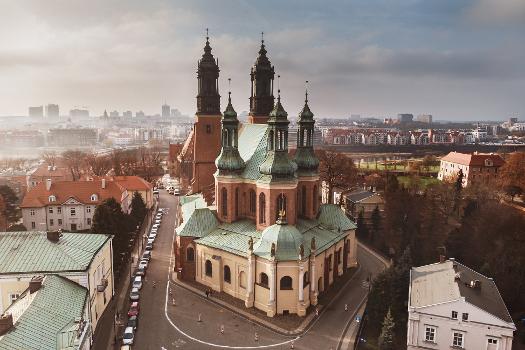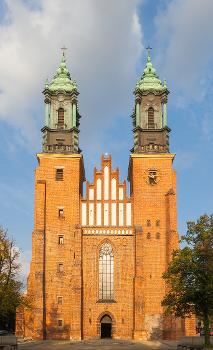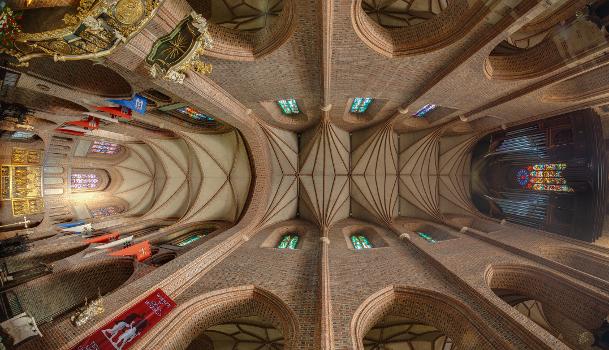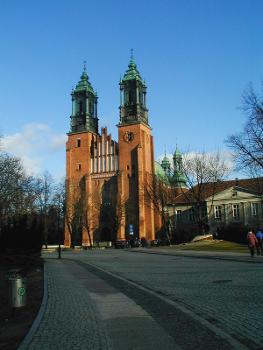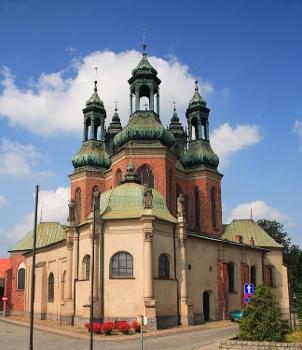General Information
| Name in local language: | Bazylika archikatedralna Świętych Apostołów Piotra i Pawła w Poznaniu |
|---|---|
| Other name(s): | Archcathedral Basilica of Saint Peter and Saint Paul |
| Beginning of works: | 10th century |
| Completion: | 15th century |
| Status: | in use |
Project Type
| Function / usage: |
Cathedral |
|---|---|
| Material: |
Masonry structure |
| Structure: |
Rib vault |
| Architectural style: |
Gothic |
Location
| Location: |
Poznań, Greater Poland Voivodeship, Poland |
|---|---|
| Coordinates: | 52° 24' 41.75" N 16° 56' 55.43" E |
Technical Information
There currently is no technical data available.
Excerpt from Wikipedia
The Archcathedral Basilica of St. Peter and St. Paul in Poznań is one of the oldest churches in Poland and the oldest Polish cathedral, dating from the 10th century. It stands on the island of Ostrów Tumski northeast of the city center.
History
The cathedral was originally built in the second half of the 10th century within the fortified settlement (gród) of Poznań, which stood on what is now called Ostrów Tumski ("Cathedral Island"). This was one of the main political centers in the early Polish state and included a ducal palace (excavated by archaeologists since 1999, beneath the Church of the Virgin Mary which stands in front of the cathedral). The palace included a chapel, perhaps built for Dobrawa, Christian wife of Poland's first historical ruler, Mieszko I. Mieszko himself was baptised in 966, possibly at Poznań – this is regarded as a key event in the Christianization of Poland and consolidation of the state. The cathedral was built around this time; it was raised to the status of a cathedral in 968 when the first missionary bishop, Bishop Jordan, came to Poland.
Saint Peter became the patron of the church because, as the first cathedral in the country, it had the right to have the same patron as St. Peter's Basilica in the Vatican. The pre-Romanesque church which was built at that time was about 48 meters in length. Remains of this building are still visible in the basements of today's basilica. The first church survived for about seventy years, until the period of the pagan reaction and the raid of the Bohemian duke Bretislav I (1034–1038). The cathedral was rebuilt in the Romanesque style, remains of which are visible in the southern tower.
In the 14th and 15th centuries, the church was rebuilt in the Gothic style. At that time, a crown of chapels was added. A fire in 1622 did such serious damage that the cathedral needed a complete renovation, which was carried out in the Baroque style. Another major fire broke out in 1772 and the church was rebuilt in the Neo-Classical style. In 1821, Pope Pius VII raised the cathedral to the status of a Metropolitan Archcathedral and added the second patron - Saint Paul. The last of the great fires occurred on 15 February 1945, during the liberation of the city from the Germans. The damage was serious enough that the conservators decided to return to the Gothic style, using as a base medieval relics revealed by the fire. The cathedral was reopened on 29 June 1956. In 1962, Pope John XXIII gave the church the title of minor basilica.
Text imported from Wikipedia article "Poznań Cathedral" and modified on June 3, 2020 according to the CC-BY-SA 4.0 International license.
Participants
Currently there is no information available about persons or companies having participated in this project.
Relevant Web Sites
- About this
data sheet - Structure-ID
20025834 - Published on:
06/01/2007 - Last updated on:
23/01/2022

